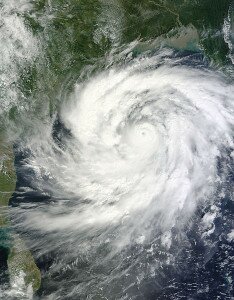Correspondent (Asia: South)
NEW DELHI – Cyclone Phailin struck India’s eastern coast last Saturday with all its fury – destroying remote villages, making a mess of power lines, felling trees like a deck of cards and blowing away thousands of homes (huts).

Although the magnitude of devastation by Phailin is believed to be huge, initial reports confirm that the damage to life was minimal. This can surely, but solely, attributed to the remarkable disaster management services in India, which – in previous cyclonic conditions – failed with catastrophic human consequences.
Odisha and Andhra Pradesh appear to be out of danger, though heavy rains have now caused a massive challenge for rescue and aid.
The accurate prediction of the cyclone by the Indian Meteorological Department, the steps taken for the quick response to early warnings of Phailin’s potential and a well-timed evacuation of an enormous number of people from Odisha and Andhra Pradesh on the part of the authorities are optimistic signs that the country’s disaster management authority has finally got its act together. Given the history of the Indian Meteorological Department, the information and efforts by the government are commendable. Given the fact that the country has not had enough time to recover from the killer cloudburst in Uttarakhand in July, earlier this year.
Taking into consideration a minor number human casualties and the surprisingly quick response on the part of the government to restore power and mobile connectivity in areas that bore the brunt of Phailin’s force are signs of a much improved and dedicated disaster management, which have often been found wanting in the past.
Half the battle is won when a co-ordinated plan is well executed by the backing of solid and relevant meteorological information. Given the sheer dedicated efforts of the authorities, it is no surprise that the United Nations also has praised the work done by the concerned authorities in relation to Cyclone Phailin.
ODISHA BRACING FOR RELIEF CHALLENGE
The challenges of facing Cyclone Phailin are over but the Odisha government now faces humungous challenges. To start with the government needs to come up with concrete efforts about distributing relief to millions of people affected by the cyclone. And to add to that, the government also needs to pacify or rather, make people believe that they can manage to get back to terms as far as earning their livelihood is concerned. The people residing in the state have a huge task in front of them but they need to be strong in order t at least take the first right step in trying to get their lives back to normal.

The government also faces a huge challenge of distributing food for the people in the state. The challenge is particularly severe in the Ganjam district, which is the worst affected area because of Cyclone Phailin. The Central Government is doing all in its power to restore normal services and is also providing full assistance to the state administration.
Prime Minister Manmohan Singh has directed the Cabinet Secretariat to provide any sort of assistance required that the state needs.
The first major challenge that the government faces is to provide food to all the people affected. As far as initial estimates are to be believed, Ganjam district alone requires an estimated 400,000-quintal of rice for over 800,000 families. This is roughly equivalent to 4,000 truckloads of rice.
The government has done extremely well till now but the challenge has just begun. In addition to ensuring speedy and effective relief, the government has to tread carefully to keep the ever-expected and never-ending politics away from the situation.
Image Courtesy: Wikimedia Commons (NASA, MODIS, Subhashish Panigrahi, Jagadhatri)
Anshul Sharma
Latest posts by Anshul Sharma (see all)
- Cyclone Phailin: Lives Saved, Livelihood Still a Challenge - October 28, 2013
- Maldives Supreme Court Annuls Presidential Election Result - October 20, 2013
- Madhya Pradesh Stampede Toll Rises to 115 - October 20, 2013








No comments
Be the first one to leave a comment.